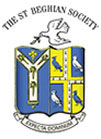|
 |
The Old St Beghian | |
| January 2022 | |||
Walter Fletcher (G 58-64) remembers Gus Walker whose daughter he married:
“The services career of Gus is well documented and indeed a book, written by Squadron Leader Dennis Sawdon, was at some stage available from the Yorkshire Air Museum, and nearby the museum one of the access roads is called ‘Gus Walker Road’.
When I married Brenda Jane Walker (daughter of ‘Gus’) in 1971 in the Henry VII Chapel in Westminster Abbey, also known as the Chapel of the Knights of the Order of the Bath and the location of the Battle of Britain stained glass memorial window, Gus, as a KCB, then had a stall in the chapel affixed with coat of arms and a flag or banner above.
I first met him at the Cambridge University Air Squadron Annual Dinner 1965 at which he was the guest of honour. We talked for a while after dinner; I was aware that he had been to St Bees as the visiting dignitary for Inspection Day 1964, which was in the term after I had left.
At that time, I shared ‘digs’ with John Coles (FN 58-64) and I mentioned to John that I had met a ‘most interesting and entertaining’ Old St Beghian at the CUAS dinner. John later told me that he believed Gus had a daughter at Girton College and that he had a friend (Becky) who had a friend (Jenny) who knew Jane; John then arranged for a tea party at Girton to be held by Jenny and to which both Jane and I would be invited.
Of course none of this would have happened had it not been that Dacre Watson (SH 56-62) piloted a single engine plane in a fly-past on Inspection Day, probably 1961. That day, we stood waiting in our ranks on the Crease for quite a while; a nearby cadet fainted and chipped a tooth on the boot of a cadet in front. Then came the impressive and exciting fly-past by Dacre. Very soon after, I applied for an RAF Flying Scholarship and thus gained the pilot training which then enabled me to do the flying instead of standing at attention on the Crease all day. In 1963 I did the fly-past in an Auster Workmaster (crop-sprayer) from Carlisle Aerodrome. Consequently, upon going up to university, I joined the Air Squadron and of course attended the Annual Dinners.
Gus and Lady Walker, like many RAF folk, got to know East Anglia well as there were many airfields spread through all the Eastern counties. After the war, they acquired a cottage in Brancaster Staithe and had many enjoyable years there. I remember they often met up with and/or played golf with ex-services people. ‘Laddie’ Lucas was often about, Douglas Bader also; it was Bader who said to Gus after a golf game against us: ‘Well, Gus, with two legs and three arms between us, we still beat them!’
Gus was Captain of Royal West Norfolk GC in 1973.
Jane and I migrated to Australia in 1976 and Gus and Brenda visited us every year
thereafter, staying for between four weeks and three months. When walking in the streets of Sydney, inevitably one person and often more would approach him, tug on the flapping right sleeve of his jacket and say ‘Hello, Sir, do you remember me? Sergeant ‘Mick’ Miller from 61 Squadron at RAF Syerston in 1942’ or similar. He was so well remembered and popular with all who ever met him.In the year he died, 1986, Gus led the ‘Odd Bods’ in Sydney on the ANZAC Day Dawn Service and traditional march commemorating Gallipoli. Many Australians, following the outbreak of WW2, made their own way to the UK to volunteer and serve in various air force entities; as a result, returning to Australia, they had no unit with which to identify and with whom to march on ANZAC Day. So known locally as the Odd Bods, ‘The Pathfinders & Aircrew Europe Squadron Association’ was formed to bring them all together under one banner every ANZAC Day.”
Home
The St Beghian Society
St Bees School,
St Bees, Cumbria, CA27 0DS.
Tel: (01946) 828093 Email: osb@stbeesschool.co.uk
Web: www.st-beghian-society.co.uk
![]()